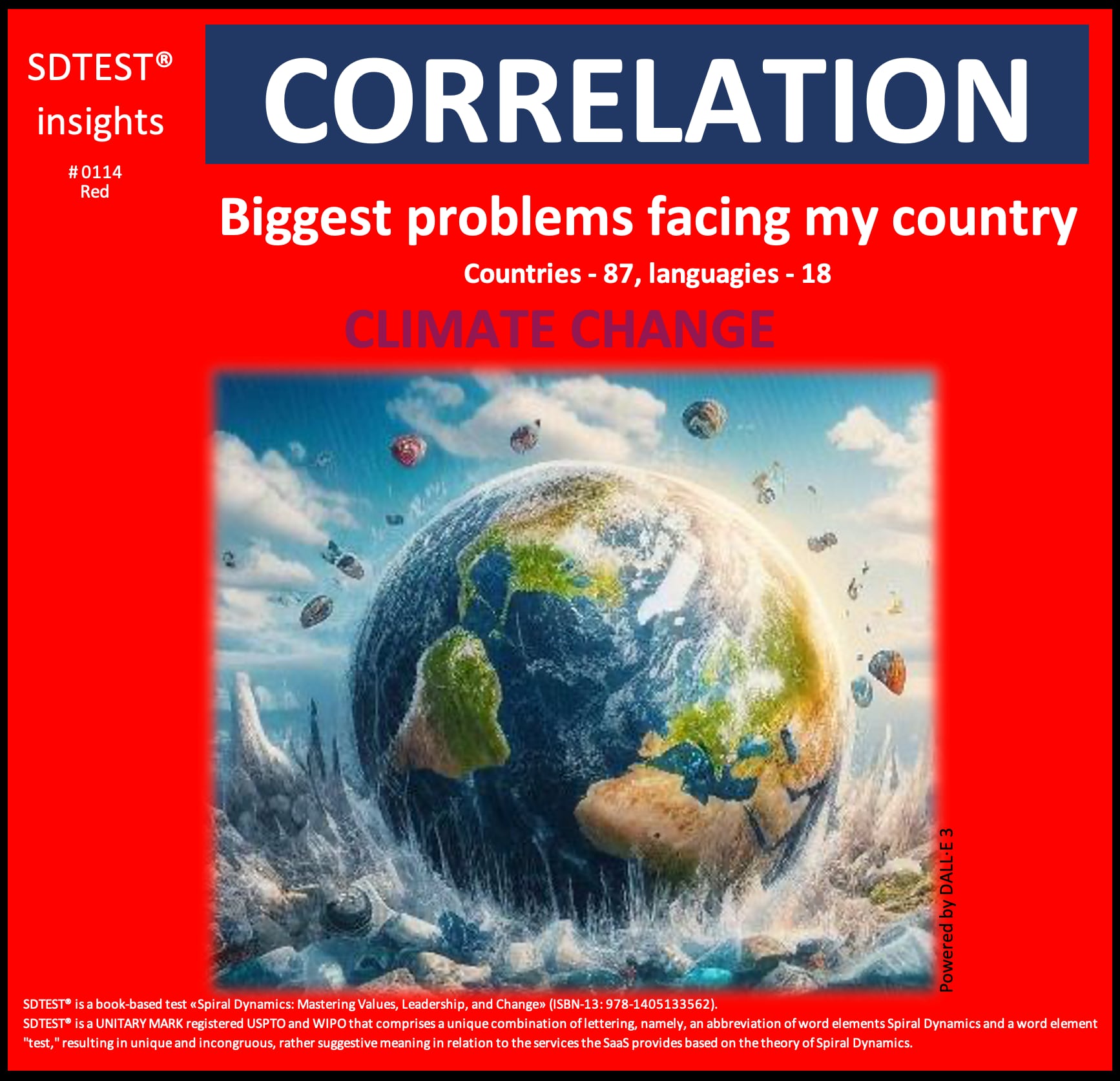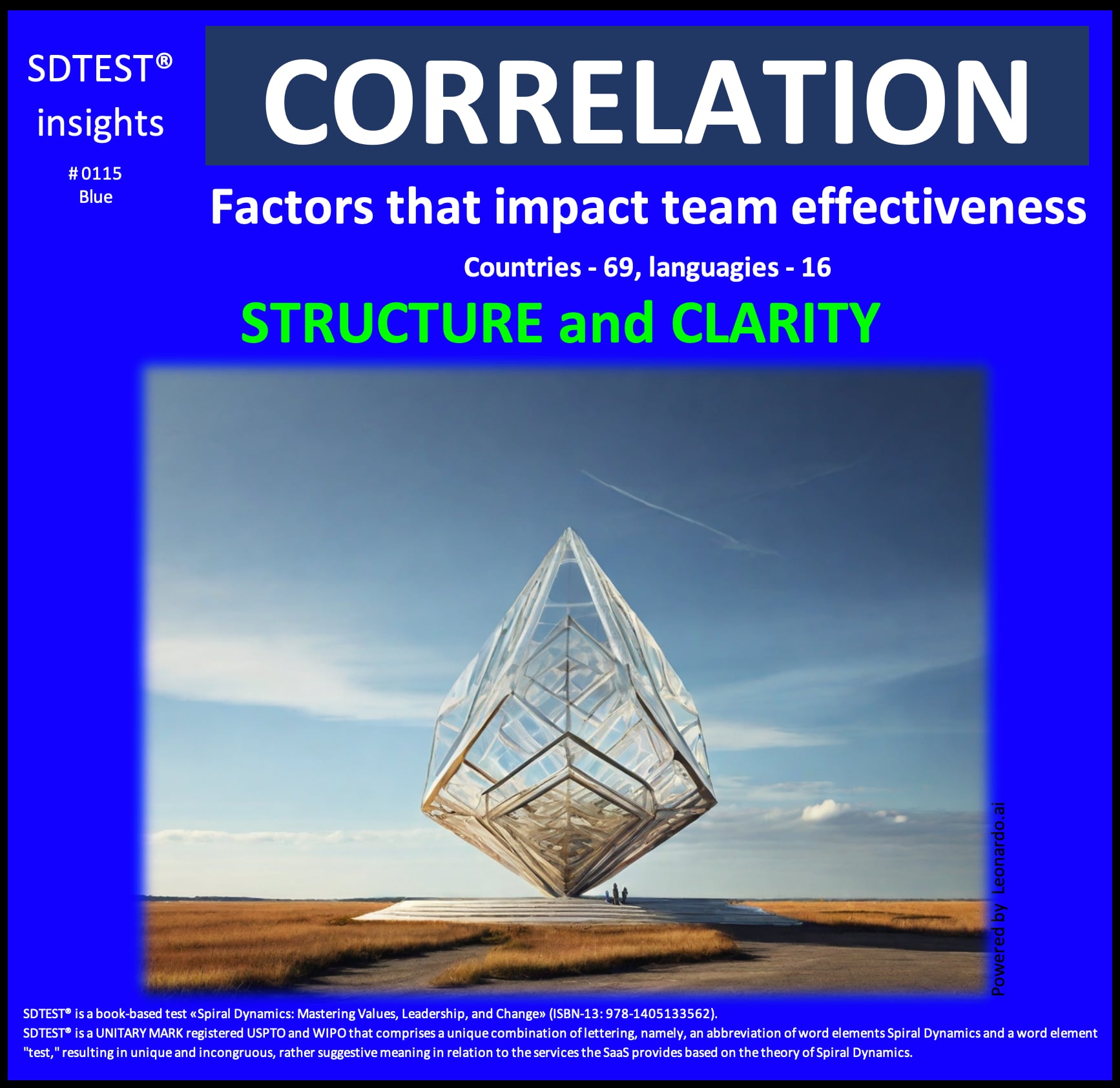Mastering Values, Leadership, and
Change» (ISBN-13: 978-1405133562)

SDTEST® has 33 different VUCA polls that calculate the 12,299 correlation values between stages of development according to the theory of Spiral Dynamics and answer options of these 33 polls.
We invite curiosity about the systemic mechanisms behind this correlation. There may be hidden variables that provide alternative explanations.
0.1405 between the Sent employees on unpaid vacations and the Purple stage.
The critical value of the correlation coefficient for a normal distribution, by William Sealy Gosset (Student) r = 0.0572. This positive correlation of 0.1405 meets the reliability criteria but does not necessarily imply causation.

This positive correlation of 0.1405 could be explained from the perspectives of companies and individuals operating within the Purple value system, which emphasizes tradition, spirituality, belief in the supernatural, and a strong sense of community and belonging.
1) From the perspective of companies operating within the Purple value system:
This positive correlation suggests a relationship between companies aligned with the Purple worldview and the decision to send employees on unpaid vacations. Such companies may perceive this action as a necessary sacrifice for the greater good of the collective, in line with the Purple value system's emphasis on maintaining harmony and respecting the wisdom of influential leaders or elders. Sending employees on unpaid vacations is a way to uphold traditions and preserve the established order, even in challenging circumstances.
2) From the perspective of individuals within the Purple value system:
This positive correlation indicates a higher association between individuals operating within the Purple stage of value system development and their acceptance or tolerance of companies sending employees on unpaid vacations. For these individuals, rooted in traditional agricultural societies, the community's collective well-being and preserving established customs and practices are paramount. The decision to send employees on unpaid vacations may be perceived as a necessary sacrifice for the greater good, aligning with the Purple value system's emphasis on maintaining harmony and respect for the guidance of influential leaders or higher authorities.
It is important to note that this positive correlation does not necessarily imply an endorsement or approval of sending employees on unpaid vacations within the Purple value system. Instead, it may reflect an acceptance or a more fatalistic attitude towards such decisions, stemming from the belief in the community's collective well-being and the adherence to the laws and beliefs of ancestors.
In addressing issues related to personnel management, labor practices, and the intersection of cultural traditions and modern business practices, it may be beneficial for both companies and individuals to incorporate elements of the Purple value system, such as promoting a sense of community, respecting traditions and spiritual beliefs, and acknowledging the guidance of influential leaders or elders. By recognizing and accommodating these deeply ingrained values, organizations and societies can foster an environment that balances preserving cultural identity with pursuing sustainable and ethical business practices while respecting the perspectives and beliefs of individuals within the Purple value system.
-0.1421 between the Climate change and the Red stage.
The critical value of the correlation coefficient for a non-normal distribution, by Spearman r = 0.0021. This negative correlation of -0.1421 meets the reliability criteria but does not necessarily imply causation.

This negative correlation of -0.1421 suggests an inverse relationship between recognizing climate change as one of the country's biggest problems and individuals operating within the Red stage of value system development. Those aligned with the Red worldview tend to associate less with identifying climate change as a pressing issue.
Individuals in the Red stage may perceive climate change as a distant or abstract concern, overshadowed by their more immediate impulses and desires for self-expression and personal gain. The Red worldview values assertiveness, competitiveness, and the ability to act swiftly and decisively to achieve one's goals. This could lead to disregarding or minimizing long-term global issues like climate change.
Furthermore, the Red value system is characterized by disregarding rules, laws, or established norms, which may extend to a dismissal of scientific consensus or international efforts to address climate change. Individuals operating within this value system may view such efforts as attempts to impose external constraints on their personal freedoms and desires.
However, it is essential to note that this negative correlation does not necessarily imply a complete denial or lack of awareness of climate change within the Red value system. Instead, it may reflect a prioritization of personal interests and immediate concerns over long-term, global challenges that may not directly or immediately impact the individual's pursuit of power, self-expression, and immediate gratification.
From the lens of the Red value system, this correlation could be interpreted as a reflection of the focus on personal desires, immediate gratification, and the pursuit of individual power and dominance over external forces or constraints.
0.0745 between the Structure and clarity and the Blue stage.
The critical value of the correlation coefficient for a normal distribution, by William Sealy Gosset (Student) r = 0.0608. This positive correlation of 0.0745 meets the reliability criteria but does not necessarily imply causation.

This positive correlation of 0.0745 could be explained from the perspectives of both teams and individuals operating within the Blue value system, which emphasizes order, rules, tradition, duty, discipline, and adherence to moral codes handed down by higher authorities.
1) From the perspective of teams operating within the Blue value system:
This positive correlation suggests a relationship between teams aligned with the Blue worldview and the recognition of structure and clarity as critical factors impacting team effectiveness. Such teams may strongly emphasize well-defined processes, clear lines of authority, and prescribed roles and responsibilities, aligning with the Blue value system's focus on order, strict hierarchies, and adherence to established rules and moral codes.
2) From the perspective of individuals within the Blue value system:
This positive correlation indicates a higher association between individuals operating within the Blue stage of value system development and their acknowledgment of the importance of structure and clarity for effective teamwork. For these individuals, adherence to established norms, codes of conduct, and clearly defined roles is paramount for fostering a cohesive and productive team dynamic.
It is important to note that this positive correlation does not necessarily imply a rigid or inflexible approach to teamwork within the Blue value system. Instead, it may reflect a belief that structure, clarity, and adherence to prescribed norms and responsibilities are essential for maintaining order, upholding ethical principles, and fostering a sense of collective accountability and duty within teams and organizations.
In addressing issues related to team effectiveness, organizational dynamics, and fostering a productive and cohesive work environment, it may be beneficial for both teams and individuals to incorporate elements of the Blue value system, such as promoting clear communication channels, defining roles and responsibilities, and fostering a sense of duty and loyalty to the team or organization. By recognizing and accommodating these profoundly ingrained values, teams and organizations can develop strategies that align with the Blue value system's perspective while ensuring a balance between structure and adaptability, ultimately contributing to overall effectiveness and success.
0.1248 between the Career opportunities and the Orange stage.
The critical value of the correlation coefficient for a normal distribution, by William Sealy Gosset (Student) r = 0.0647. This positive correlation of 0.1248 meets the reliability criteria but does not necessarily imply causation.

This positive correlation of 0.1248 could be explained from the perspectives of companies, teams, and individuals operating within the Orange value system, emphasizing reason, science, technology, progress, efficiency, and rational, logical thinking.
1) From the perspective of companies operating within the Orange value system:
This positive correlation suggests a relationship between companies aligned with the Orange worldview and their recognition of career opportunities as a priority for job seekers. Companies may strongly emphasize providing clear professional growth and advancement paths, aligning with the Orange value system's focus on achievement, progress, and tangible results.
2) From the perspective of teams operating within the Orange value system:
This positive correlation indicates a higher association between teams operating within the Orange stage of value system development and their acknowledgment of the importance of career opportunities for attracting and retaining talent. For these teams, driven by a desire for knowledge, efficiency, and the application of scientific and technological methods, offering opportunities for professional development and career advancement may be a critical factor in fostering a motivated and high-performing workforce.
3) From the perspective of individuals within the Orange value system:
This positive correlation suggests that individuals aligned with the Orange worldview tend to emphasize career opportunities more when evaluating potential job prospects. For these individuals, rooted in a rational, analytical, and goal-oriented mindset, the ability to progress in their careers, acquire new knowledge, and achieve tangible results is paramount.
It is important to note that this positive correlation does not necessarily imply disregarding other factors, such as compensation or work-life balance, within the Orange value system. Instead, it may reflect a recognition that career opportunities, professional growth, and the ability to learn and advance continuously are vital components of personal and professional fulfillment within this value system.
In addressing issues related to talent acquisition, employee engagement, and fostering a motivated and productive workforce, it may be beneficial for companies, teams, and individuals to incorporate elements of the Orange value system, such as promoting continuous learning opportunities, providing clear paths for career advancement, and fostering a culture of achievement and progress. By acknowledging and accommodating the Orange value system's unique perspective, organizations can develop strategies aligning with their values while ensuring a balance between individual growth, team cohesion, and overall organizational success.
-0.1222 between the Influential and the Green stage.
The critical value of the correlation coefficient for a normal distribution, by William Sealy Gosset (Student) r = 0.0431. This negative correlation of -0.1222 meets the reliability criteria but does not necessarily imply causation.

This negative correlation of -0.1222 could be explained from 3 points of view:
1) Companies operating within the Green value system:
Companies that embody the Green value system would likely view the negative correlation between "Influential" and the Green stage as indicating that authentic leadership is not about wielding power or influence over others. Instead, they would see effective leadership as fostering unity, cooperation, and a shared sense of purpose within the organization. These companies would prioritize building successful teams through empowerment, consensus-building, and a focus on the well-being of all stakeholders rather than relying on the influence of a few key individuals.
2) Teams operating within the Green value system:
Within teams operating in the Green value system, the negative correlation would suggest that the most influential leaders are not those who seek to exert influence over others but rather those who can facilitate a collaborative, holistic approach to problem-solving and decision-making. Green-aligned teams would likely value leaders who can help the team recognize the interconnectedness of their work and its impact on the broader community and environment rather than those who rely on their authority or status.
3) Individuals within the Green value system:
For individuals who embody the Green value system, the negative correlation between "Influential" and the Green stage would indicate a preference for leaders who can foster a sense of unity, cooperation, and shared responsibility within the team. These individuals would be drawn to leaders who can help the team see the bigger picture and work towards sustainable, holistic solutions rather than those who seek to exert influence or control over the group.
The negative correlation of -0.1222 suggests that within the Green value system, the most influential leaders can facilitate a collaborative, systems-thinking approach that prioritizes the entire community's well-being rather than those who rely on their influence or authority. This insight aligns with the Green value system's emphasis on unity, cooperation, and a concern for the greater good.
-0.1052 between the Age group 35-39 and the Yellow stage.
The critical value of the correlation coefficient for a normal distribution, by William Sealy Gosset (Student) r = 0.0841. This negative correlation of -0.1052 meets the reliability criteria but does not necessarily imply causation.

This negative correlation -0.1052 means that as the age group 35-39 increases, the values of the Yellow stage decrease. This suggests that individuals in this age group may be less likely to identify with the Yellow value system, characterized by the ability to integrate and transcend previous systems, a holistic, systems-thinking approach, and a focus on personal growth and development.
For companies operating within the Yellow value system, this negative correlation may indicate a challenge in attracting and retaining talent aged 35-39. This age group may focus more on personal and family responsibilities and less on personal growth and development, which are critical features of the Yellow value system.
For teams operating within the Yellow value system, the negative correlation may suggest a need for more diversity in age and experience, which can impact team dynamics and performance.
For individuals within the Yellow value system, the negative correlation may indicate a shift in priorities and values as they move through different life stages. This shift may be driven by personal and family responsibilities, impacting their ability to embrace the Yellow value system fully.
Overall, the negative correlation between the age group 35-39 and the Yellow stage highlights the importance of understanding and addressing different age group's unique needs and priorities within a company or team. By recognizing and addressing these differences, companies, and teams can create a more inclusive and supportive work environment that values diversity and personal growth.
0.1151 between the Yes, I am ready to receive 15% less pay to work remotely and the Turquoise stage.
The critical value of the correlation coefficient for a normal distribution, by William Sealy Gosset (Student) r = 0.0655. This positive correlation of 0.1151 meets the reliability criteria but does not necessarily imply causation.

The positive correlation of 0.1151 could be explained from three points of view:
1. Companies operating within the Turquoise value system:
Companies embracing this value system may be more open to flexible work arrangements that prioritize the well-being of their employees and the planet. Turquoise-aligned companies may recognize the potential benefits of remote work, such as reduced commuting time and carbon emissions. They may offer reduced pay as a trade-off for these benefits.
2. Teams operating within the Turquoise value system:
Within teams operating in the Turquoise value system, the positive correlation may indicate a greater appreciation for the interconnectedness of personal, professional, and environmental well-being. Team members may view remote work as balancing personal and professional responsibilities while contributing to a more sustainable future. This holistic approach to work may foster a more collaborative and supportive team environment where individuals feel valued for their unique contributions and are encouraged to prioritize their well-being.
3. Individuals within the Turquoise value system:
For individuals operating within the Turquoise value system, the positive correlation may reflect a deep commitment to sustainability and the well-being of both people and the planet. These individuals may be more likely to prioritize remote work to reduce their carbon footprint and contribute to a more sustainable future, even if it means accepting reduced pay. This holistic, integrative approach to work and life may lead to a more fulfilling and meaningful career path, where individuals are valued for their unique contributions and are encouraged to prioritize their well-being and the planet's well-being.
What insights do you gain from today's correlation? How might we study this relationship more carefully before deducing causation?
We welcome respectful and wise perspectives! Stay tuned every week as we share more results and insights.
After login or registration, free access to the poll results in the FAQ section.
